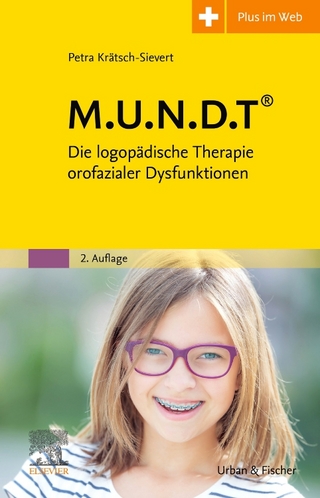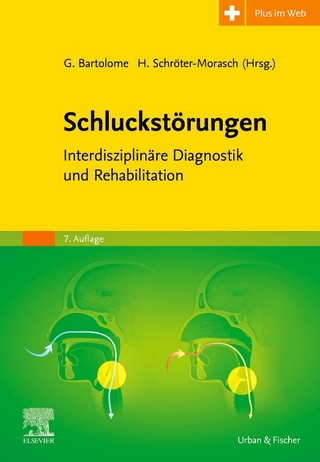
Treatment Resource Manual for Speech-Language Pathology
Plural Publishing Inc (Verlag)
978-1-63550-118-6 (ISBN)
- Titel ist leider vergriffen;
keine Neuauflage - Artikel merken
The thoroughly revised Sixth Edition of the best-selling Treatment Resource Manual for Speech-Language Pathology remains an ideal textbook for clinical methods courses in speech-language pathology, as well as for students entering their clinical practicum or preparing for certification and licensure. It is also a beloved go-to resource for practicing clinicians who need a thorough guide to effective intervention approaches/strategies.
This detailed, evidence-based book includes complete coverage of common disorder characteristics, treatment approaches, information on reporting techniques, and patient profiles across a wide range of child and adult client populations. The text is divided into two sections. The first part is focused on preparing for effective intervention, and the second part, the bulk of the book, is devoted to therapy strategies for specific disorders. Each of these chapters features a brief description of the disorder, case examples, specific suggestions for the selection of therapy targets, and sample therapy activities. Each chapter concludes with a set of helpful hints on intervention and a selected list of available therapy materials and resources.
New to the Sixth Edition
This new edition includes updated citations and references throughout as well as current information on treatment efficacy in all disorder chapters to reflect recent developments in the field. In addition, the authors have added the following:
A new chapter on Contemporary Issues including critical thinking, telepractice, simulation technologies, and coding and reimbursement
New tables on skill development in gesture, feeding, and vision
New information on therapist effects/therapeutic alliance
Coverage of emerging techniques for voice disorders and transgender clients
Expanded information on:
Childhood Apraxia of Speech, Cochlear Implants, Cultural and Linguistic Diversity, Interprofessional Practice, Shared Book-Reading, Traumatic Brain Injury, Treatment Dosage/Intensity, Vocabulary Development
Key Features:
Bolded key terms with an end-of-book glossary
A multitude of case examples, reference tables, charts, figures, and reproducible forms
Lists of Additional Resources in each chapter
Access to a PluralPlus companion website containing PowerPoint lecture slides and quizzes for each chapter, and all of the forms from the book in digital format for easy duplication and customization to specific experiences
Froma P. Roth, PhD, is a Professor Emeritus at the University of Maryland, College Park, Maryland, in the Department of Hearing and Speech Sciences. She currently serves as the Associate Director of Academic Affairs and Research Education at the American Speech-Language-Hearing Association in Rockville, Maryland. Professor Roth received her bachelor's degree from Hunter College, her master's degree from Queens College, and her doctoral degree from the Graduate Center of the City University of New York. Dr. Roth's current research and clinical interests focus on language/literacy and learning disabilities.+++++++++++++++++++++++++++Colleen K. Worthington, MS, is a Clinical Professor and the Director of Clinical Education in Speech-Language Pathology within the Department of Hearing and Speech Sciences at the University of Maryland, College Park. She received her bachelor's degree from the University of Maryland and her master's degree from Loyola College, Baltimore. Ms. Worthington's primary professional interests include diagnostic principles/methods and the supervisory process.
List of Tables
Case Examples by Disorder
List of Forms and Figures
Preface
Acknowledgments
About the Authors
Part One. Preparing for Effective Intervention
Chapter 1. The Essential Ingredients of Good Therapy: Basic Skills
Philosophy
Universal Design Principles for Learning: An Overarching Framework
General Principles of Intervention
Programming
Selection of Therapy Targets
Sequencing of Therapy Targets
Generalization/Carryover
Termination of Therapy
Formulation of Behavioral Objectives
Theories of Learning
Innateness Theory/Biological Model
Behavioral Model
Constructivism/Interactionist/Integrative Model
Behavior Modification
Types of Reinforcement
Positive Intervention and Behavioral Supports (PBIS)
Schedules of Reinforcement
Key Teaching/Scaffolding Strategies
Homework
Session Design
Basic Training Protocol
Task Order
Dynamics of Therapy
Group Therapy
Data Collection
Recording Session Data
Probes
Collaborative Service Delivery Models
Multi-Tiered Systems of Support (MTSS)/Response to Intervention
Current Challenges of RTI
Treatment Efficacy/Evidence-Based Practice
Treatment Intensity and Dosage
Setting Specific Professional Terminology
Troubleshooting Tips for Therapy Sessions
Conclusion
Additional Resources
Appendix 1-A: Therapy Observation Checklist
Appendix 1-B: Worksheet for Identifying Behavioral Objectives
Appendix 1-C: Worksheet for Formulating and Writing Behavioral Objectives
Appendix 1-D: Sample Daily Therapy Plan
Appendix 1-E: Daily Therapy Plan
Appendix 1-F: Report of Observation Hours
Appendix 1-G: Instructions for Using Data Recording Forms
Appendix 1-H: Sample Positive Behavior Intervention and Support Plan
Chapter 2. Information Reporting Systems and Techniques
Philosophy
Technical Writing Style
Report Formats
Initial Therapy Plan
Session Notes
Progress and Final Reports
Tips for Proofreading Clinical Reports
Individualized Education Program
Due Process
Individualized Family Service Plan
504 Plan
Professional Correspondence
Health Insurance Portability and Accountability Act
Additional Resources
Appendix 2-A: Health Insurance Portability and Accountability Act (HIPAA)
Appendix 2-B: Sample Initial Therapy Plan
Appendix 2-C: Sample Progress Report
Part Two. Providing Treatment for Communication Disorders
Chapter 3. Intervention for Articulation and Phonology in Children
Treatment Approaches
Traditional
Motor-Kinesthetic
Distinctive Features
Paired Oppositions-Minimal and Maximal
Phonological Processes
Cycles Approach
Core Vocabulary
Metaphon
Oral Motor Considerations
Treatment Efficacy and Evidence-Based Practice
Target Selection for Intervention Programming
Developmental
Nondevelopmental
Example Profiles for Functional Articulation
Disorders
Sample Activities
Helpful Hints
Example Profiles for Phonological Disorders
Sample Activities
Helpful Hints
Organic Articulation Disorders
Cleft Palate
Example Profile
Sample Activities
Helpful Hints
Hearing Impairment
Example Profile
Sample Activities
Helpful Hints
Childhood Apraxia of Speech
Example Profile
Sample Activities
Helpful Hints
Conclusion
Articulation and Phonology
Oral-Motor Dysfunction
Additional Resources
Articulation
Phonology
Appendix 3-A: Phonetic Placement Instructions for Difficult-to-Teach Sounds
Appendix 3-B: Diadochokinetic Rates for Children
Introduction to Chapters 4 and 5. Introduction to Language Intervention for Children and Adolescents
Classification of Language Disorders
Relationship Between Oral Language and Literacy
Role of the Speech-Language Pathologist in Literacy
Theoretical Models of Intervention
Treatment Efficacy/Evidence-Based Practice
Chapter 4. Intervention for Language in Infants and Preschool Children
Intervention with Infants (Birth to 3 Years)
ASHA Early Intervention Guidelines
Helpful Hints
Intervention with Children (3 to 5 Years)
Treatment Approaches for Infants, Toddlers, and Preschoolers
Emergent Literacy Intervention (Birth Through Preschool Years)
Example Profiles
Sample Activities
Helpful Hints
Conclusion
Additional Resources
Appendix 4-A: Developmental Language Milestones: Birth to 5 Years
Appendix 4---B: Gross and Fine Motor Developmental Milestones
Appendix 4-C: Stages of Cognitive Development
Appendix 4-D: Gesture Developmental Milestones: 9-16 Months
Appendix 4-E: Development of Vision
Appendix 4-F: Feeding Developmental Milestones
Appendix 4-G: Stages of Play Development
Appendix 4-H: Developmental Toy List
Appendix 4-I: Examples of Lessons from "Promoting Awareness of Speech Sounds" (PASS)
Chapter 5. Intervention for Language in School-Age Children Through Adolescence
Characteristics of Students Ages 5-10 Years
Characteristics of Adolescents 10-18 Years
Intervention Considerations for School-Age Children and Adolescents
The Common Core State Standards
Treatment Approaches for School-Age Children and Adolescents
Instructional Strategies for Writing
Example Profiles
Sample Activities
Helpful Hints
Conclusion
Additional Resources
Appendix 5-A: Types of Cohesion
Chapter 6. Intervention for Autism Spectrum Disorder (ASD)
Overview of Autism Spectrum Disorder
Incidence
Etiology
Characteristics of Children with ASD
Social Communication
Repetitive/Restricted Behaviors, Interests, and Activities
Language
Emergent Literacy and Literacy
Medications
Outcomes
Treatment Efficacy/Evidence-Based Practice
Treatment for Autism
Theoretical Models
Treatment Approaches
Example Profiles
Helpful Hints
Conclusion
Additional Resources
Chapter 7. Intervention for Adult Aphasia with Introduction to Traumatic Brain Injury
Aphasia
Classification of Aphasia Syndromes
Treatment Efficacy/Evidence-Based Practice
Treatment for Aphasia
Neuroplasticity
Theoretical Orientations to Aphasia Treatment
Guidelines for Programming and Implementing Therapy
Specific Intervention Procedures
Example Profiles
Sample Activities
Helpful Hints
Conclusion
Additional Resources
Traumatic Brain Injury
Communication
Cognition
Behavior
Treatment Efficacy/Evidence-Based Practice
Treatment for Traumatic Brain Injury
Helpful Hints
Conclusion
Additional Resources
Appendix 7-A: Suggestions for Enhancing Verbal Interaction with a Family Member with Aphasia
Appendix 7-B: Guidelines for Conversational Coaching
Chapter 8. Intervention for Motor-Speech Disorders: The Dysarthrias, Apraxia of Speech, and Dysphagia
Treatment for Motor-Speech Disorders
The Dysarthrias
Treatment Efficacy/Evidence-Based Practice
Treatment for the Dysarthrias
Example Profiles
Sample Activities
Helpful Hints
Apraxia of Speech
Treatment Efficacy/Evidence-Based Practice
Treatment for Apraxia of Speech
Example Profiles
Sample Activities
Helpful Hints
Conclusion
Additional Resources
Dysphagia
Treatment for Dysphagia
Helpful Hints
Conclusion
Additional Resources
Chapter 9. Intervention for Fluency
Categories of Stuttering Behaviors
Core Behaviors
Secondary Behaviors
Developmental Disfluencies Versus Stuttering
Treatment for Fluency Disorders
Treatment Efficacy/Evidence-Based Practice
Intervention Techniques
Example Profiles
Helpful Hints
Conclusion
Additional Resources
Appendix 9-A: Sample Phrases, Questions, and Monologues
Chapter 10. Intervention for Voice and Alaryngeal Speech
Voice Disorders
Classification of Voice Disorders
Treatment Efficacy/Evidence-Based Practice
Treatment for Voice Disorders
Intervention Techniques
Example Profiles
Sample Activities
Helpful Hints
Alaryngeal Speech
Treatment for Alaryngeal Clients
Mechanical Devices
Esophageal Speech
Tracheoesophageal (TEP) Speech
Example Profile
Sample Activities
Helpful Hints
Conclusion
Additional Resources
Appendix 10-A: Additional Dialogue Scripts for Voice Therapy Activities
Chapter 11. Client and Family Counseling
Five Key Traits of an Effective Counselor
Stages of Counseling
Establishing the Therapeutic Relationship
Implementing Counseling Intervention
Terminating the Therapeutic Relationship
Client and Family Emotional Reactions to Communicative Disorders
Counseling Techniques for Communicative Disorders
Group Counseling
Family Systems Counseling
Helpful Hints
Conclusion
Additional Resources
Chapter 12. Multicultural Issues in Intervention
Cultural Competence
Cultural/Ethnic Background
Socioeconomic Status (SES)
Linguistic Differences
Clinical Considerations for Children
Terminology
Patterns of Second Language Acquisition
Educational Models
Clinical Considerations for Adult Populations
Clinical Considerations for Multilingual Populations with Language Disorders
Helpful Hints
Conclusion
Additional Resources
Chapter 13. Contemporary Issues
Critical Thinking
Components of Critical Thinking
Strategies/Techniques for Promoting Critical Thinking
Telepractice
Privacy and Regulatory Issues
Basic Clinician Competencies with Technology
Candidates for Telepractice Services
Simulation Technologies
Standardized Patients (SPs)
Computer-Based Learning Experiences (CBLE)
Implementation
Coding and Reimbursement
CPT Codes
ICD-10 Codes
Documentation
Conclusion
Appendix A. ASHA Code of Ethics
Appendix B. International Phonetic Alphabet Symbols
Appendix C. Glossary of Selected Medical Terms
Appendix D. Schematic of the Vocal Tract
References
Index
| Erscheinungsdatum | 12.11.2019 |
|---|---|
| Verlagsort | San Diego |
| Sprache | englisch |
| Maße | 219 x 279 mm |
| Themenwelt | Medizin / Pharmazie ► Gesundheitsfachberufe ► Logopädie |
| ISBN-10 | 1-63550-118-0 / 1635501180 |
| ISBN-13 | 978-1-63550-118-6 / 9781635501186 |
| Zustand | Neuware |
| Informationen gemäß Produktsicherheitsverordnung (GPSR) | |
| Haben Sie eine Frage zum Produkt? |
aus dem Bereich


